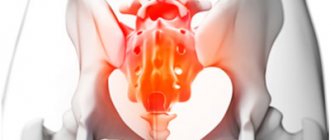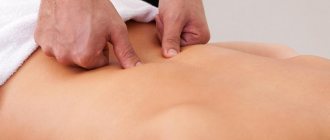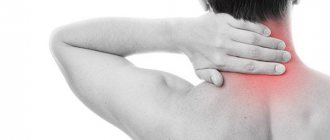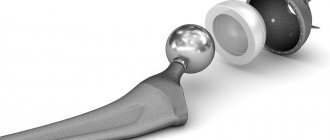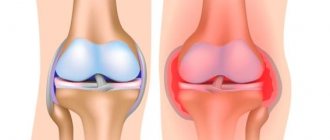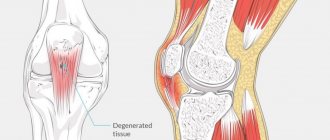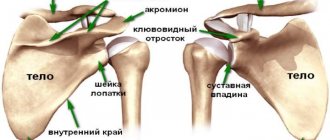Osteochondrosis is a modern disease that affects exclusively the human species due to the structural features of the spine associated with upright posture. While walking on your feet, the entire load falls on the spine; as a result, the intervertebral discs cease to perform their functions, the bones begin to rub against each other, causing pain and discomfort.
Why does osteochondrosis occur?
The disease is aggravated if an adult leads a sedentary lifestyle, is overweight, or abuses junk food. According to statistics, almost every inhabitant of our planet, to one degree or another, faces manifestations of osteochondrosis.
In four out of five cases, pain in the cervical or dorsal spine is associated specifically with osteochondrosis. The degree of pain depends on the stage of intervertebral disc damage.
With age, a vascular bed is formed in the intervertebral discs of a person, due to which the nutrition of all tissues is carried out according to the principle of diffusion. Some discs, due to this arrangement of blood vessels, receive insufficient nutrition, and as a result, tissue regeneration slows down. Instead of recovering from excessive stress, micro- or macro-trauma, the discs begin to gradually deteriorate.
Advertising:
Insufficient blood circulation also causes the intervertebral cartilage to receive insufficient nutrients. Over time, such cartilage loses its elasticity and strength, it becomes thinner, deformed, and no longer protects the bones from friction against each other.
Despite the constant development and improvement of medicine, the exact causes of the development of osteochondrosis in men and women are still unknown. Some doctors insist that the impetus for the onset of the disease is given by any infectious disease or inflammatory process in the joints or other tissues. It is not possible to cure the problem completely; constant maintenance therapy is required.
Correction of an ingrown toenail is carried out conservatively or radically. Most patients prefer gentle methods in order to avoid surgical intervention. Read more in the article: “ointments for treating ingrown toenails.”
Causes of osteochondrosis
It is generally accepted that osteochondrosis can be provoked by various factors; in some cases, a whole set of adverse effects on the body leads to the development of the disease.
Risk factors include:
- problems with metabolism, various malfunctions of the metabolic system;
- heredity (it has been established that if one of your close relatives suffers from osteochondrosis, most likely the disease will manifest itself in you);
- low physical activity, problems with the musculoskeletal system, flat feet and other similar diseases;
- general intoxication of the body, inflammatory processes;
- microcracks formed on the intervertebral discs as a result of excessive loads, injuries, fractures, bruises, etc.;
- malnutrition (when the body receives an insufficient amount of nutrients necessary to maintain the spine, cartilage and intervertebral discs in a healthy condition);
- insufficient fluid intake into the body;
- abuse of smoking and alcoholic beverages, which cause spasm and dilation of blood vessels;
- living in an area with high air humidity and low temperatures.
Despite the many reasons that cause osteochondrosis, in most cases the disease develops due to an incorrect lifestyle.
Conservative therapy is the main method for inflammation of the glans and foreskin of the male genital organ. Treatment of balanoposthitis with drugs is prescribed depending on the causes of the disease. Read more in the article: “treatment of balanoposthitis in men.”
Foraminotomy
Foramintomy is used for osteochondrosis accompanied by foraminal intervertebral stenosis and radicular pain syndrome. Decompression technology is carried out under the control of CT fluoroscopy, endoscope or microscope. Decompression of neural structures using the foraminotomy method is the expansion of the intervertebral (foraminal) foramen by removing the pathologically changed part of the vertebra (bone spines), possibly with a small part of the disc. Recently, foraminotomy has been performed using an endoscope, which has significantly reduced the degree of surgical invasion.
A neurosurgical session often involves the use of general anesthesia. If the main technical component of the control will be an endoscope, a small incision is made, usually not exceeding 1 cm. Through the incision, an endoscopic probe, which is equipped with a powerful light-emitting source and a video camera, is carefully brought to the pathological object, avoiding dangerous areas. Looking at the intraoperative screen, where information from the anatomical spaces of the spinal system is received thanks to the endoscope, the surgeon removes all stenotic factors. In order to remove bone or fibrocartilaginous tissue, micro-instruments are used that are inserted into the working compartment of the endoscope probe.
Disease prevention
To reduce the likelihood of developing stage 2 osteochondrosis, it is important to exercise and watch your diet. The following physical exercises have a positive effect on the dorsal and cervical spine:
- Independent kneading of the back, shoulder girdle, upper and lower extremities, lower back in the morning.
- Physical warm-up (swinging movements with arms and legs, pull-ups on the horizontal bar, push-ups, rotation of the head in different directions).
- Constant breaks between work with 5 minutes of physical activity (a set of standard exercises with several repetitions). Physical education is especially important for people who spend most of their time in a sitting position.
- Swimming in the pool, aerobics in the water.
It is important to begin preventive exercises long before the first symptoms appear. As soon as osteochondrosis begins to manifest itself as discomfort and pain, the list of physical exercises will have to be significantly expanded. Before starting exercises for the back and spine with osteochondrosis, it is important to consult with a medical specialist who will select suitable loads and adjust the training program so that they are truly beneficial and do not harm the body.
How to get rid of the “hump” on the neck
There are several treatment methods, each with their own benefits, but they are effective under certain conditions.
Even before starting treatment, it is necessary to check and correct hormonal levels. Thus, for women during menopause, hormone replacement therapy has a very good effect.
Expert comment:
“Please do not start self-medication without consulting your doctor. Only he can determine the true cause of the problem.
If the root cause is curvature of the spine in the cervical region, you need an osteopath.
If medications are used, then without stopping them, even surgical methods do not help for long, and the fatty lump on the neck will appear again.
All my advice below will only help with the fatty nature of the hump and only for those who have taken control of its root cause.”
Maxim Vasiliev, plastic surgeon.
Nutrition for osteochondrosis
When treating osteochondrosis at home, it is important not only to do physical exercises, but also to eat right. An important element for restoring the functioning of the spine is protein. If you have been diagnosed with the disease, protein should be included in every meal. At the same time, it is worth reducing the intake of mushrooms and butter to a minimum. It is better to give preference to vegetarian dishes; the best cooking method is boiling, stewing, baking or steaming with a minimum amount of oil.
Advertising:
With osteochondrosis, various spices are allowed to add flavor to dishes, while the intake of salt into the body should be limited to a minimum.
Various salted foods are also contraindicated - pickled cucumbers and tomatoes, salted salmon and herring, etc.
The amount of baked goods eaten (especially rich ones) and those containing a large amount of sugar is reduced to a minimum.
Among drinks, it is better to give preference to ordinary purified water or herbal teas. Tea made from chamomile, mint and lemon balm has a positive effect on the body. You can drink freshly squeezed juices (store-bought options are not suitable due to the large amount of sugar in the composition; grape juice is not suitable either).
Correct daily diet:
- about 1-1.5 liters of water;
- no more than 2600 Kcal;
- dividing the diet into 5-7 meals.
Be sure to give up alcoholic beverages, strong coffee and smoking, otherwise all preventive and treatment measures taken will be useless.
Laminectomy
The spinal technique is common for osteochondrosis, which has caused a narrowing of the spinal canal with pinching of nerve formations. The essence of laminectomy is the resection of the lamina (arch) of the vertebra, thereby achieving decompression of the nerve root. The intervention can be an independent procedure or an auxiliary method to another operation to ensure maximum access to the contents of the spinal canal cavity.
Anesthesia during surgery is of a general type. The patient is placed on his stomach or side. The incision that provides access to the vertebrae can be from 3 cm to 10 cm in length. After dissecting and spreading the soft tissue over the area of interest, under X-ray control, the vertebral arches are removed (partial or complete) using pliers. Often, some fragment of the facet joints also needs to be cut.
If the procedure was used as an auxiliary method, surgical actions will continue to eliminate the hernia, osteophytic growths, scar formations, etc. Note that laminectomized bone units are too susceptible to destabilization. Therefore, at the final stage after any intervention where laminectomy was used, vertebral fusion is performed.
Types of osteochondrosis
Before you begin treating osteochondrosis at home, you need to identify exactly what type of disease you suffer from. Depending on the location of the problem, it is customary to distinguish:
- Cervical osteochondrosis
. Diagnosed in 25% of cases. Initially, it manifests itself as painful sensations in the shoulder girdle; as it progresses, it can cause compression of the vertebral artery. The problem with squeezing is accompanied by the appearance of noise in the ears, floating spots and colored spots before the eyes, dizziness and nausea, especially with a sudden change of position due to squeezing of the brain vessels. - Thoracic osteochondrosis
. The main symptom is a feeling of discomfort in the thoracic spine and chest, a feeling of “a stake in the chest.” As the disease develops, the pain gradually spreads to nearby organs - the heart, lungs, stomach, pancreas, etc. A feeling of “overcrowding” arises. - Lumbosacral osteochondrosis
. The most common type of disease, diagnosed in 50% of cases. Mostly, patients consult a doctor with acute pain in the lumbar region. As the disease develops, the pain spreads to the legs and groin area; in advanced cases, the patient experiences a loss of sensitivity in the legs. - Osteochondrosis in several departments
. The most severe form of the disease, which without proper treatment can cause disability.
Regardless of the type of osteochondrosis, without a medical examination, only a preliminary diagnosis can be made, requiring subsequent confirmation.
How to treat thoracic osteochondrosis?
Before determining how to treat thoracic osteochondrosis, it is important to visit a specialist. Diagnosis of the disease should be carried out only by a specialist. Treatment of osteochondrosis of the thoracic spine is determined by a neurologist after a high-quality examination.
The key rule for starting treatment for thoracic osteochondrosis is getting rid of pain. Today, there are several optimal treatment options. Let's look at each of them in more detail.
Physiotherapy
Physiotherapeutic treatment of thoracic osteochondrosis is used in medical practice quite often, both at the acute stage and after it, in order to achieve long-term remission of the disease.
For osteochondrosis of the thoracic spine, physiotherapy methods are used such as:
- medicinal electrophoresis - the combined effect of direct current and drugs;
- UHF therapy – exposure to high-frequency electromagnetic fields;
- Magnetic therapy is an alternative medicine that involves the use of a constant or alternating magnetic field;
- phonophoresis of drugs - administration of drugs under the influence of ultrasound;
- detensor therapy – relaxation of the muscular frame of the spine using a specialized mattress/mat.
It is important to note that when prescribing physiotherapeutic methods for treating a degenerative disease, the stage of its development is taken into account. Inappropriate use of physiotherapeutic treatment can aggravate the situation and exclude the possibility of long-term remission.
Massage for osteochondrosis of the thoracic region
Massage is one of the most effective methods of non-drug treatment of thoracic osteochondrosis.
Providing a reflex massage effect provides a positive effect on the affected area of the spinal column, which provokes a positive dynamics of treatment.
Unlike other parts of the spine, the thoracic spine requires a special approach when massaged. The muscle fibers of this zone have a special threshold of action.
The positive effects of massage procedures are manifested in:
- reducing the level of pain;
- improving blood circulation at the location of the disease;
- eliminating muscle spasms;
- increasing arm muscle strength;
- increasing the mobility of the spinal column and launching regenerative processes of cartilage tissue.
Among the basic principles of thoracic massage it is worth highlighting:
- the beginning of the session should be carried out with light strokes, which will ensure blood flow and reduce pain;
- during the massage it is recommended to use squeezing movements, rubbing and patting;
- each movement must be repeated 4-5 times;
- movements should be carried out along a single trajectory: from the shoulder blades to the neck, upward;
- each side of the thoracic region should be treated separately.
Exercise therapy for thoracic osteochondrosis
Physical therapy (therapeutic physical education) classes provide the opportunity to provide high-quality support for the optimal tone of the muscular frame of the back and help relieve soreness of the paravertebral muscles.
Exercise therapy for osteochondrosis of the thoracic region is most effective in the initial stages of the development of the disease.
When doing gymnastics, it is important to consider and adhere to the basic rules for performing exercises for osteochondrosis of the thoracic region, including:
- systematic repetition over several months;
- the duration of the lesson should not exceed half an hour;
- gymnastics for thoracic osteochondrosis should be performed without the use of additional equipment;
- You should only exercise in comfortable clothes and shoes;
- taking into account existing contraindications.
Absolute contraindications include:
- acute cardiac pathologies;
- increased body temperature (more than 37.6°C);
- oncological diseases;
- mental instability;
- dermatological diseases;
- high blood pressure.
Consultation with a neurologist in combination with a reasonable, competent approach to exercise ensures the successful achievement of remission at various stages of the disease.
Signs of osteochondrosis
Advertising:
The main sign of osteochondrosis is the presence of aching pain in the area affected by the disease. The patient may experience numbness in the limbs, a sensation of “pins and needles” under the skin, and constant lumbago, especially with a sudden change of position.
Painful sensations with osteochondrosis intensify when sneezing and coughing due to muscle spasms, excessive physical exertion or prolonged exposure to an uncomfortable position.
The diagnosis of “osteochondrosis” can be made to the patient in advance based on the complaints that the patient presented with.
The diagnosis is further confirmed using various examinations:
- initial examination by a medical specialist with palpation of the spinal column in various body positions;
- hardware examination of the spine using MRI, CT;
- Dopplerography of cerebral vessels.
If the patient seeks medical help in advanced stages, medical examinations can also identify concomitant diseases.
Common complications of osteochondrosis include radiculitis, hernia, kyphosis, etc. It is important to properly conduct a diagnostic examination of the body, only this will eliminate the presence of other spinal diseases that have similar symptoms.
Diagnostics
If you have any disturbing symptoms, you should consult a doctor. The doctor will take a medical history and clarify the specifics of the pathological process, what exactly is troubling you, how long ago the symptoms began, whether there are concomitant diseases, etc. Despite the fact that the symptoms of osteochondrosis are quite pronounced and characteristic, you will additionally need to undergo a series of diagnostic tests research.
As a diagnosis, an x-ray of the spine in the area where the pain is bothering may be prescribed. For a clearer picture, your doctor may recommend a computed tomography or magnetic resonance imaging scan.
After establishing an accurate diagnosis and its severity, the specialist will prescribe effective treatment and tell you how to relieve pain in cervical osteochondrosis and other localizations of the pathological process.
Treatment of osteochondrosis
Treatment of osteochondrosis at home is only possible if the disease is at an early stage, if it has not yet caused any complications and the process is still reversible. In advanced cases and with minimal internal resources in the body, surgical intervention cannot be avoided.
The type of treatment is selected depending on the complexity of the disease and the results of the medical examination. Regardless of the chosen treatment program, it is important to adhere to an integrated approach in order to achieve results and consolidate them for a long time.
Conservative treatment and recovery after surgery is mainly based on two principles - taking medications to restore the functions of damaged intervertebral discs and hardware treatment.
Hardware treatment includes the following methods:
- physical therapy (in the initial stages you will need to visit a medical specialist who will tell you what to do and how to do it correctly, then the exercises can be done at home, especially if no special devices are required);
- manual therapy from a specialist;
- underwater hydromassage of problem areas;
- following a therapeutic diet with limiting the intake of harmful foods;
- wearing a corset;
- etc.
Properly designed hardware treatment allows you to minimize the use of medications. At the same time, it will not be possible to quickly relieve the problem without medication.
Treatment of diseases with “Solnyshko” devices
One of the effective methods of treating osteochondrosis is hardware therapy. Today, many devices are used that relieve pain and eliminate the factors of destruction of intervertebral discs. One of such devices is the AMNP-02 “Sun” magnetic therapy device.
The device is very popular among athletes. It can help reduce pain after injury. But ordinary people should also buy this device from. The device creates a magnetic field with an induction of 55±10 mT, which has a beneficial effect on the damaged area. The device reduces pain and helps eliminate further destructive processes.
Taking medications for osteochondrosis
Advertising:
It is impossible to completely avoid taking medications when treating osteochondrosis, regardless of the stage of the disease. All medications that will make the life easier for a patient suffering from discomfort can be schematically divided into several categories.
| Type of drug | Operating principle | Drugs |
| Analgesic | Relieves painful sensations. The disadvantage is that they do not eliminate the cause of the pain, but only dull it. | Any local painkillers |
| Nonsteroidal anti-inflammatory drugs | Relieves inflammation in the area of damaged intervertebral discs and cartilage, reduces temperature in the affected area. | Karipazim, Ibuprofen, Nise, etc. |
| Antispasmodic | Relieves muscle spasms, has a vasodilating effect, reduces pain | Baclofen, Botox, Myolastan, etc. |
| Antioxidants | Removes harmful substances from the body that are formed by inflammation at the site of injury | Mexidol, vitamin C, etc. |
| Preparations for stimulating blood microcirculation | Improve blood circulation in the affected area, help accelerate the process of tissue regeneration | Nicotinic acid, Teonicol, etc. |
Only the attending physician can prescribe the correct type of drug; uncontrolled use can result in serious health problems and ongoing deterioration of the condition.
Problems of treating osteochondrosis at home
Home rehabilitation of a patient diagnosed with osteochondrosis can be complicated by a number of reasons. Among the most common are:
Advertising:
- Lack of necessary medical equipment. This includes exercise equipment for restoring the body, special orthopedic beds, pillows, and devices for physiotherapeutic procedures.
- Lack of self-organization and self-discipline. Treatment and prevention of osteochondrosis requires constant exercise, seven days a week. At home, such exercises generally end with the patient either doing something later or doing nothing at all, aggravating his situation.
- Lack of skills and knowledge to create a proper diet. The effectiveness of treatment and the body’s ability to restore its lost functions through regeneration largely depend on the correctness of the selected diet.
It is advisable to carry out treatment at home at the final stage, when, after undergoing rehabilitation in specialized centers, the necessary skills have been acquired.
How to remove “withers” on the neck at home
In the initial stage, when the “hump” has just appeared, you can try to remove it yourself. According to our observations, only weight loss works here: exercise + proper nutrition.
There are no special exercises that will help you get rid of the hump on the back of your neck. Only general weight loss with a load on all large muscle groups is effective.
Acceleration of metabolism is facilitated by:
- maximum mobility - we climb the stairs on foot, and not by elevator, we walk often and for a long time;
- maintaining the room temperature no higher than 22°C.
Try removing the withers on the neck with a massage. It increases blood circulation and eliminates congestion. But you can start it only after consulting a doctor.
Unfortunately, the fat hump is one of the “fat traps” of the body, which retain fat and volume even with significant overall weight loss. Therefore, against a formed hump on the neck, conservative methods - diet, gymnastics, orthopedic corsets, folk remedies and massage are not effective, and even physiotherapy helps only temporarily.
Let's sum it up
Summarizing all of the above, we can say that it is best to undergo rehabilitation, preventive and restorative treatment after osteochondrosis in specialized institutions. Only such institutions can offer an integrated approach to solving the problem, which will ultimately lead to relief of the patient’s condition.
It is important not to self-medicate using dubious folk remedies. At best, such therapy will have no result; at worst, it will lead to a worsening of the current condition. Medicines should also be taken with caution, including those sold in pharmacies without a prescription from a doctor.
The best way to combat the disease is moderate exercise and proper nutrition, limiting junk food in the diet to a minimum.

